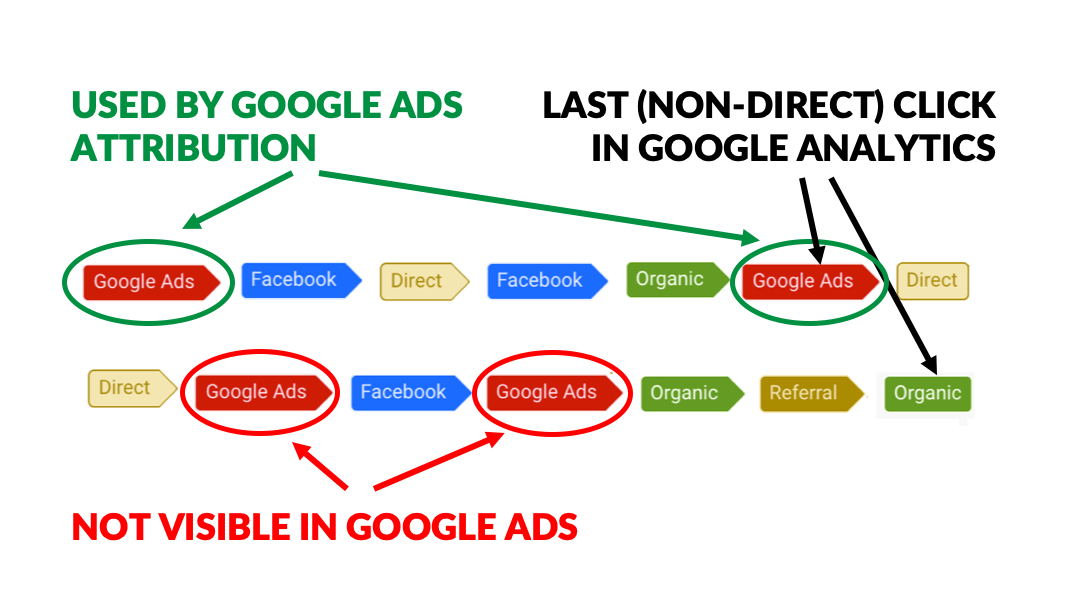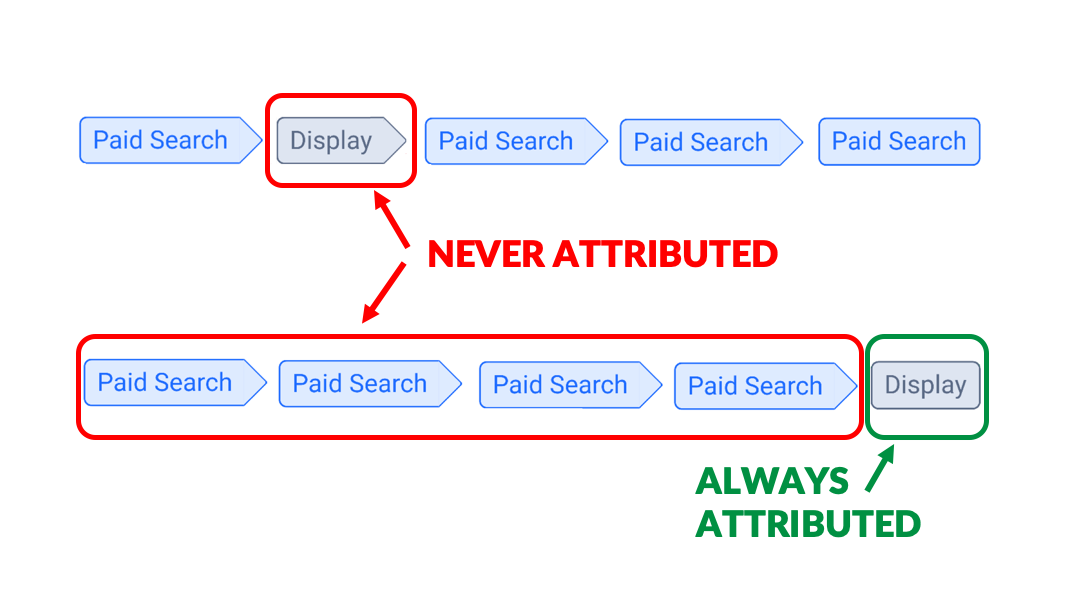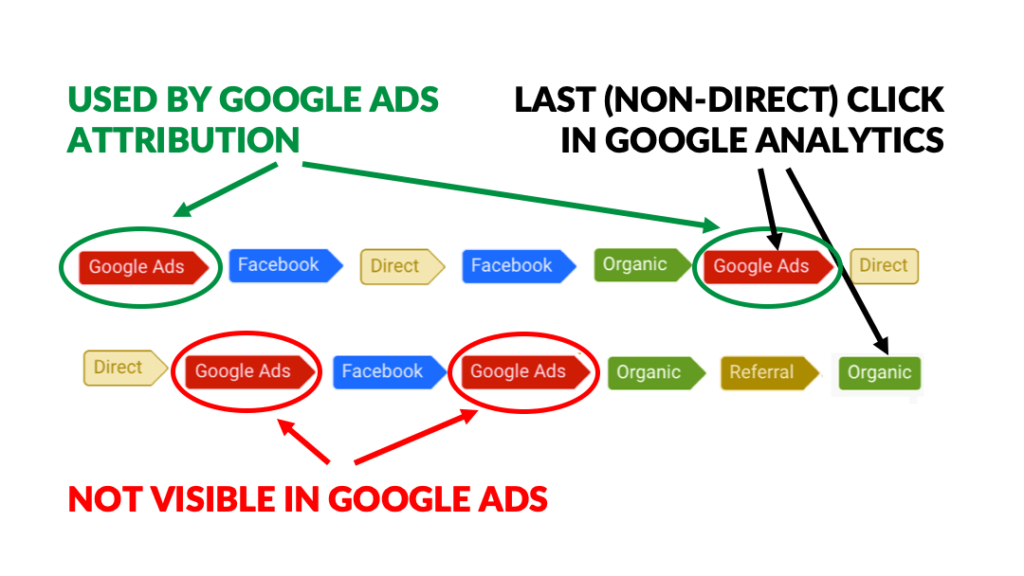As an alternative to setting up Google Ads conversion tracking, you can import conversions from Google Analytics, such as goals or transactions, and then use it for optimization of your Google Ads campaigns.
It is not a new feature, and its use by advertisers is a common practice.
It became even more popular recently, as the Smart Shopping campaigns require conversion tracking with transaction-specific values.
The import of Google Analytics transactions is probably the easiest way to comply with this requirement if there is no Google Ads conversion value tracking in place.
How Does the Import Work?
There is, however, one thing you need to know about it.
It’s not Google Ads conversion tracking using Analytics code.
It’s data import from Google Analytics to Google Ads, and a given conversion is imported to Google Ads only if it is attributed to Google Ads in the last click model in Google Analytics.
Last click in Google Analytics actually means last non-direct click because a direct visit is not a click in Google Analytics terminology.
It means that if the Google Ads click is followed by, for example, a visit from Facebook and then the user converts, this conversion won’t be imported to Google Ads.
So What?
You might say: It’s OK.
You are happy with this deduplication with Facebook traffic.
But what if the Google Ads click is followed by an organic visit from a Google search of your brand?
What if it’s a self-referral from your website that occurred due to a missing or not fired Google Analytics code?
What if it’s a referral from a live chat, web push message, or marketing automation software?
A visit from a webmail page, because the user had to recover his password?
Visit from a payment gateway?
A banner on your site because someone added UTM tags to an internal link?
In all the cases mentioned above, Google Ads won’t import this conversion from Google Analytics. The original source of this conversion, Google Ads, is overwritten by other interactions.
These interactions, however, aren’t actually traffic sources. As a result, the reported value of Google Ads traffic decreases.
What About Google Ads Attribution?
Yes, you can change the attribution model in Google Ads conversion settings to, for example, linear, position-based or data-driven model.
But Google Ads still won’t consider conversion paths other than those attributed to Google Ads by Google Analytics in the last non-direct click model.
Google Ads simply doesn’t see that these clicks were on paths to the imported conversions.
Altering the attribution model in Google Ads won’t change it.

In the case of Analytics imported conversions, attribution modeling in Google Ads is a strange construction.
For example, if you use the linear model in Google Ads, it will equally attribute the conversions to all Google Ads search clicks on their paths – but only if the Google Ads search click is the last (non-direct) click preceding the conversion in Google Analytics.
If the last click in Analytics is not a Google Ads click, the conversion won’t be attributed in Google Ads at all.
The Problematic Display
It’s worth to note that the attribution models in Google Ads other than last click work solely for Google search ads clicks.
It is because currently, Google Ads attribution modeling is only available for clicks on Search Network and Shopping ads on google.com.
It isn’t available for clicks delivered by Search Partners. It is not available for interactions with display or video ads either.
For this reason, Display ads clicks can be attributed in Google Ads only in the last click model.
Therefore:
- If a display ad click is followed by other Google Ads click on the conversion path, the conversion won’t be attributed to this display ad, regardless of the attribution model.
- If the last Google Ads click on the conversion path is a Display ad, the conversion won’t be attributed to any other Google Ads click.

The Solution
A solution to this problem may be running search and display and in separate Google Ads accounts with a separate conversion tracking on the account level.
(Don’t use cross-account conversion tracking, because the purpose of splitting the accounts is that each account has its own independent conversion tracking).
Please note that in this case, conversions with both search and display clicks on the path will be duplicated (they will appear in both Google Ads accounts).
Of course, Google Analytics will deduplicate the conversions and help you to see the entire conversion path in Multi-Channel Funnels reports.
You will be able to see the degree of overlap and decide how to take it into account, for example by adjusting the CPA/ROAS goal.
If you use conversions from Google Analytics instead of native Google Ads conversion tracking, you make it even more complicated.
Splitting the accounts won’t change the fact that you artificially decrease the volume of conversions visible for Google Ads.
Usually, this deduplication isn’t really desired. As a result, you underestimate the value of Google Ads traffic. It makes also bidding strategies’ life harder because they always work better with larger sets of data.
Don’t Stop Using It
Of course, there is nothing wrong with the import itself.
Linking Google Ads and Analytics allows you to see the ads performance data in Google Analytics.
You can import Analytics metrics like bounce rate, average session duration, and pages per session into Google Ads account. You can also create valuable Google Ads remarketing lists using Analytics data.
It is OK if you use imported conversions as additional data (“not included in conversions”). But for optimization and bid strategies, you should instead use Google Ads conversion tracking.
More Resources:
Image Credits
In-post Images: Created by author, January 2020
